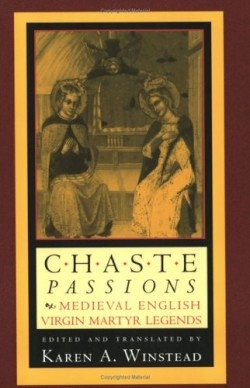Chaste Passions
Medieval English Virgin Mary Legends
These saints’ stories are anything but saintly. The tales Winstead translates in Chaste Passions are instead gory, horrific accounts of hell’s fury, religious devotion and endless purity. Modern readers may expect these old religious stories to seem lame by today’s standards. Not so. The stories remain moving, shocking and entertaining even hundreds of years after they were written.
Winstead’s extensive work recreates the effort of the original 1200 to 1485 texts, for she again brings the legends of the virgin martyrs to the lay people by putting the stories in a language that can be understood by the masses. Chaste Passions also includes appendices with transcriptions of never before edited and very rare texts.
In the first legend, that of Saint Juliana by an unknown author, readers find a young beautiful woman who refuses the marriage proposal of Eleusius, the teachings of the pagan church and the insistence of her father to embrace both. “(Eleusius) quickly ordered her yanked up by her hair. She was then pulled until she dangled well off the ground by her tresses. And they set upon her so viciously from both sides that each blow pierced her lovely body, drenching the rods with gore.” She goes on to cast an evil spirit into a pile of feces, although the language used in the legend is not quite so polite.
The variety of tales within this one topic—that of virgin martyrs—is astounding. There also is Winifred who returns to life after being beheaded by an irate suitor. Eugenia is classified as a “transvestite saint,” because she pretends to be a man and lives as a monk before her eventual demise.
There also is Ursula whose faith ends in mass martyrdom for herself and 11,000 other virgins. Winstead presents sixteen saints each with her own individual tale of faith, virginity, torture and death.
This anthology also includes images, often of paintings from the Middle Ages, that depict scenes from the stories. They set a somber and rich tone readers will appreciate. Saint Barbara is shown just before her execution. Saint Cecily of Rom and her husband Valerian are seen being crowned by an angel. Readers can view how centuries of Christians have portrayed these martyrs, imagined their lives and eventual deaths.
Thorough research clearly is the foundation for this book. Footnotes and additional information is detailed throughout. Winstead also precedes each legend or collection of legends with an analysis of the piece or pieces—the writing style and the elements that vary from the traditional. She couples informative essays with translations of intriguing stories to give readers keen insight into the virgin martyr legends, a view once reserved only for scholars.
Reviewed by
Marjory Raymer
Disclosure: This article is not an endorsement, but a review. The publisher of this book provided free copies of the book to have their book reviewed by a professional reviewer. No fee was paid by the publisher for this review. Foreword Reviews only recommends books that we love. Foreword Magazine, Inc. is disclosing this in accordance with the Federal Trade Commission’s 16 CFR, Part 255.

